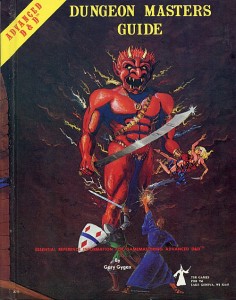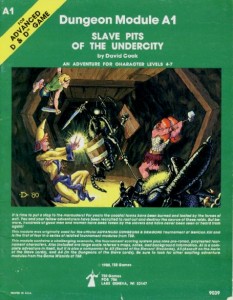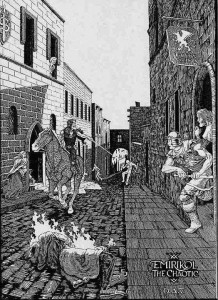The Origin of Frayed Knights: Dice and Paper Edition
Posted by Rampant Coyote on July 17, 2014
Long-time readers may be plenty familiar with some of this already. But with the first Frayed Knights game coming out on Steam (hopefully a week from today) and the sequel making progress towards its first fully playable demo, I figured I’d go back over a little bit of the history of the series.
The Frayed Knights series was inspired by a number of sources. I’ll talk about the computer RPG origins in another post, but the Bard’s Tale, Wizardry, and Ultima series (and some lesser-known games) were of course old-school classics that informed my design and I wanted to emulate some of the feel of playing those games.
But a lot of it was inspired by the source of inspiration for all of those games – dice-and-paper gaming, particularly the first edition Advanced Dungeons and Dragons era. The characters making snarky comments as if they were players sitting around the table was a direct effort on my part to capture some of that feeling, mixed with a bit of tongue-in-cheek humor, of course.
 Dice-and-paper gaming is different now. Honestly, I play Pathfinder now rather than 1st edition AD&D because I prefer the new system, and I really caught the vision of the “World of Darkness” series with its emphasis on storytelling. So don’t get me wrong – I’m not going to tell you that 1E was the be-all, end-all of gaming. But it was a different experience back then – one that was partly lost a few years later, and is only now being somewhat re-discovered by computer RPGs. The recent opinion piece at Polygon, “The dice can kill you: Why First Edition AD&D is king,” manages to describe some of that “feel.”
Dice-and-paper gaming is different now. Honestly, I play Pathfinder now rather than 1st edition AD&D because I prefer the new system, and I really caught the vision of the “World of Darkness” series with its emphasis on storytelling. So don’t get me wrong – I’m not going to tell you that 1E was the be-all, end-all of gaming. But it was a different experience back then – one that was partly lost a few years later, and is only now being somewhat re-discovered by computer RPGs. The recent opinion piece at Polygon, “The dice can kill you: Why First Edition AD&D is king,” manages to describe some of that “feel.”
That’s part of the feel I was going for.
In fact, that’s kind of the strength AND the weakness of the system. In the old 1979-era Advanced Dungeons & Dragons game, the setting and mood built into the rules. From the race and class restrictions, racial attitude modifiers, to even things like the insanity tables. You could ignore all that, sure… but if you even moderately adhered to the rules, the setting and flavor of those old D&D games would be spontaneously generated by dice roles. Kinda like a roguelike.
But perhaps more importantly, there was a geeky subculture around those early years which spread by contact with other gaming groups, conventions, and in the pages of the manuals and Dragon Magazine. It was wild stuff back then, to play a game so insanely free-form that there wasn’t even a conventional notion of a winner. Creativity ran rampant, from the mundane to the bizarre.
 Modules and supplements back then had the really awesome pulp-fantasy names like “Queen of the Demonweb Pits,” “Assault on the Aerie of the Slavelords,” “The Caverns of Thracia,” “Tomb of Horrors,” “The Ghost Tower of Inverness,” “City State of the Invincible Overlord,” “Against the Cult of the Reptile God,” “Expedition to the Barrier Peaks,” etc. Man, I loved those titles. And the modules – while not always expertly delivering on the promise of those magnificent titles – were great foundations on which a gaming group could build an experience.
Modules and supplements back then had the really awesome pulp-fantasy names like “Queen of the Demonweb Pits,” “Assault on the Aerie of the Slavelords,” “The Caverns of Thracia,” “Tomb of Horrors,” “The Ghost Tower of Inverness,” “City State of the Invincible Overlord,” “Against the Cult of the Reptile God,” “Expedition to the Barrier Peaks,” etc. Man, I loved those titles. And the modules – while not always expertly delivering on the promise of those magnificent titles – were great foundations on which a gaming group could build an experience.
That was really the key. While everyone who had played The Keep on the Borderlands had somewhat similar experiences based on the module, it was a little (or a lot) different for everyone. When I envision an “ultimate computer RPG” – which I hope to play (or even build) one day, that’ll be a major part of it. A luxuriously hand-crafted world and plot, and the player has a ton of freedom to do things how he wants, and have the game react appropriately. It was a (distant) goal in Frayed Knights, which resulted in lots of duplicate dialogs with slightly different variations.
The banter at the table was of course a major part of trying to recapture that experience as well. My mental model for the world was a campaign setting invented by a gifted, earnest, but not entirely clueful 14-year-old with delusions of grandeur (sound familiar?), totally missing the lack of logical consistency inherent in both the world and the rules. Hey, that means I did all that deliberately, doesn’t it? The party members are characters played by somewhat more experienced players who are playing along and just having fun role-playing their characters, papering over the inconsistencies in the world with brilliant explanations for why things work the way they do.
 Some of the aspects of old-school D&D and similar games I just imitated (I won’t say I parodied or paid homage to, but maybe there was a little of both) was the ungodly number of spells (and items) in the core game. It’s both brilliant and terrible. For me, trying to balance all these items and spells was a little bit on the terrible side. But the point of AD&D was to make sure there was so many cool things for players to use (or have used against them) that the game would stay interesting through dozens of campaigns. It worked!
Some of the aspects of old-school D&D and similar games I just imitated (I won’t say I parodied or paid homage to, but maybe there was a little of both) was the ungodly number of spells (and items) in the core game. It’s both brilliant and terrible. For me, trying to balance all these items and spells was a little bit on the terrible side. But the point of AD&D was to make sure there was so many cool things for players to use (or have used against them) that the game would stay interesting through dozens of campaigns. It worked!
For the most part, I only tried to reference / parody the feel of those old game sessions of that era. There were a few specifics that I remember making fun of. The Caverns of Anarchy are, of course, a reference to the Caves of Chaos in The Keep on the Borderlands. Honestly, I don’t think of it as a great module – I think Gygax was kinda phoning it in on that one to throw in an obligatory introductory adventure for their new, streamlined, simpler version of D&D. (As an aside, I think the 1981 Basic / Expert D&D set was one of their best-designed products, ever). But it was the first D&D experience for many players of the era, and it was a pretty early one for me, too. The “mad hermit” kinda makes an appearance, although he explains that he’s not mad, just mildly pissed-off and cantankerous. I deliberately avoided much more by way of specific references to that module, but instead took the idea in a few directions, keeping only the concept of a bunch of monster lairs in close proximity (a “monster apartment complex” as I once heard it described).
The level of randomness of the dice & paper games is something else I emulated, although I actually backed off a good deal from my original efforts. When three or four battles in 1st edition Advanced D&D would take up a great deal of a four-hour gaming session, the randomness of the occasional die-roll feels more acceptable. But in a computer game, when combats are resolved in a couple of minutes, there are LOTS of rolls, lots of chances to die, and players (including me) get frustrated with too much inconsistency.
Some of the other stuff – well, I’ll just say I spent a lot of time going over old Dragon Magazine articles and classic modules, rulebooks, and supplements for both ideas and a proper “old-school dice & paper feel” for the game. Whether I succeeded or not is in the eye of the beholder, I suppose. But I have certainly enjoyed the experience.
Filed Under: Frayed Knights - Comments: 2 Comments to Read
Daniel King said,
After playing 4th ed D&D for years my group went back to 2nd. It’s so much more enjoyable, it less about power combos and more about having fun, actually roleplaying.
ShadowTiger said,
I am working on what is not exactly an “ultimate rpg” but something that really embodies the experience of an open world story based pen & paper setting. I do draw heavily from the different groups i play D&D with but also from other video games.
I am super excited about all the design that has been completed but being a part time developer i am totally caught up in the producer role when i need to be engineering things.
Anyways, it is cool to see your inspiration as it gives me confidence that i too can ship something someday!